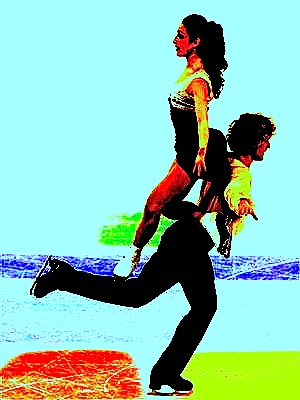
I’m posting a trifle later than usual tonight, campers, resulting in more of a Tuesday morning post than my planned Monday evening billet-doux to standard format for manuscripts. I blame the Olympics; does the coverage ever stop? Just when I manage to tear my weary eyes away from ice dancing, three hours of curling magically appear after midnight. It’s as if somebody in the programming department said, “You know what I’d really like to do this year? Schedule seven-hour blocks of competition in events where the athletes wear jewelry on ice.”
Oh, you may laugh, but have you taken a gander at the wrists, earlobes, and/or necks of the women curlers over the last few days? My eyes may be bleary from overuse, but I could have sworn that the U.K.’s wunderkind was sporting a charm bracelet today. On her throwing hand.
Enough frivolity. Back to business.
A few days ago, I introduced something that Millicent the agency screener just loves to see, a properly-formatted first page of a manuscript. It looked, if you will recall, a little something like this:
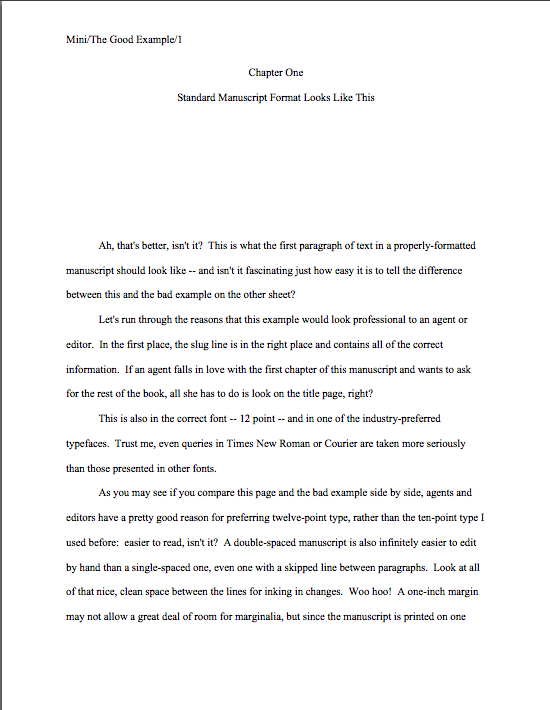
This is also, in case you had been wondering, what the opening of each subsequent chapter should look like as well: on a fresh page, 14 single lines from the top. Or, to put it another way, 6 double-spaced lines under the chapter title. (For those of you who do not know how to insert a hard page break into a Word document, it’s located under the INSERT menu. Select BREAK, then PAGE BREAK.)
Not certain what that might look like in practice? Okay, here’s an example I have ready to hand: the first page of the sixth chapter of my memoir might conceivably look like this:

I said might, because actually, I’m not a big fan of chapters named Chapter Six, even if they happen to be the sixth chapter in the manuscript. It’s sort of like dubbing a suburban street lined with elm trees Elm Street: there’s nothing inherently wrong with a straightforward descriptive title, of course, but you must admit, it’s not precisely going to come as a shock to many readers when Chapter Six appears immediately after Chapter Five.
All of which is a rather heavy-handed lead-in (inevitable, perhaps, after having spent so many hours watching curling) to a question I’m sure many title-namers out there have been harboring: how should a titled chapter be formatted? Specifically, if a chapter has a title, should it also be numbered?
In a word, yes. The chapter title appears, centered, on the first double-spaced line under the chapter number, also centered.
As, indeed, we’ve already seen in today’s first example. But in furtherance of my ongoing mission to place so many examples of correctly-formatted manuscript pages in front of your weary eyes that you’ll start automatically recoiling from pages in published books, muttering, “Well, that wouldn’t work in a manuscript submission, let’s take a gander at another one:

Actually, I had an ulterior motive in showing you that last example: in comparing it to the example just before it, do you notice anything about the amount of space between the chapter number and the beginning of the text?
If you immediately shot your hand into the air, exclaiming, “By gum, Anne, the area between the two appears identical! You’ve simply placed the chapter title within it, you clever lady,” award yourself 1700 Brownie points. (Or a bronze medal — there seem to be an awful lot of them lying around these days.) Regardless of whether a chapter’s opening page contains a chapter designation, a title, or both, the text begins the same distance from the top of the page.
The same logic would apply, of course, to any other section-breaking information you might care to include at the beginning of a chapter — alerting the reader to a break between Part I and Part II of a book, for instance. While we’re at it, let’s take a look at that in practice: if Chapter 6 were the beginning of Part II of the book (it isn’t, but we aim to please here at Author! Author!), I would have formatted it thus:
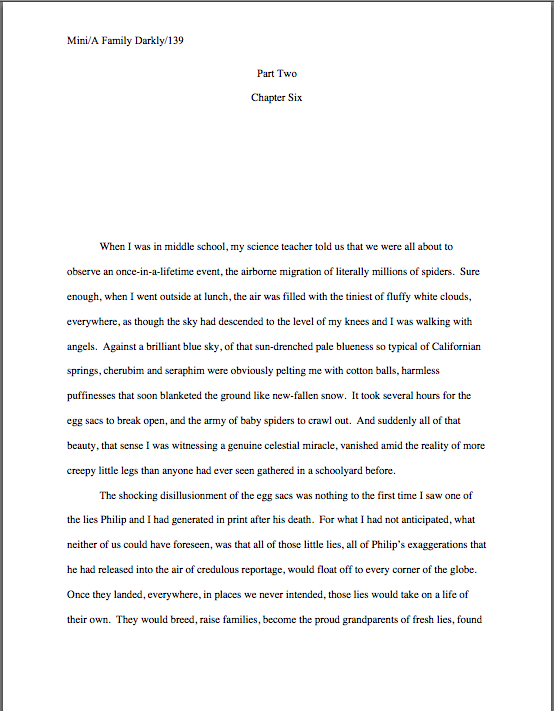
Starting to get the hang of this?
Not yet completely comfortable? Okay, let’s try inserting another common piece of introductory information: identifying a narrator-du-chapter in a multiple point-of-view novel.
If the switch comes at the beginning of a chapter, it couldn’t be easier: it’s simply another reader-signal that belongs above the pre-text white space, right? To see this principle in action, let’s pretend our ongoing example is fiction (which it isn’t; my middle school honestly was pelted with migratory spiders) and place the narrator’s name in the traditional spot:
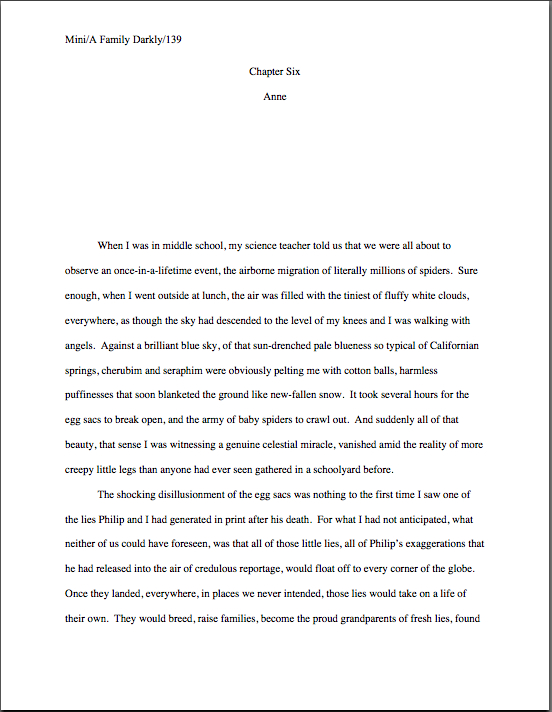
That’s the way one would handle the matter in a manuscript like, say, Barbara Kingsolver’s THE POISONWOOD BIBLE, where the narrator changes with the chapter. If there were also a chapter title (perhaps not advisable in this case, as there’s already significant information at the top of that page for the reader to absorb), it would go between the chapter heading and the narrator identifier.
I would show you an example of that, but it’s late; there’s curling on, and I’m positive that you can extrapolate.
You’re thinking that there must be an easier way to format the first page of a chapter than to memorize the way it should look and reproduce it from scratch each time, aren’t you? You’re not alone, if so; most seasoned authors probably wouldn’t appreciate my revealing a working secret, but pretty much everyone worries that someday her will forget to hit return one of the necessary times, so that Chapter 5 will begin — gasp! — ten lines from the top, while Chapter 1-4 and 6 on will begin twelve lines down.
I know: gives you the willies even to contemplate how Millicent might react to that level of formatting inconsistency, doesn’t it? Double-check each and every chapter opening before you submit; trust me, you’ll be happier in the long run.
Ooh — that was an unpopular suggestion, wasn’t it? Fully a third of you have your hands waving impatiently in the air. “That’s an absurdly time-consuming suggestion, Anne,” the irate third huff. “Oh, I understand that the chapter number or title needs to appear at the top of the first page and each subsequent chapter; I’m perfectly happy to leave five double-spaced blank lines between it and the first line of text, so the first paragraph starts six lines down. But surely there’s an easier way to do this — a template or something? Perhaps Word has some sort of default setting I can employ so I need never worry about the issue again as long as I live?”
Standard format templates do exist, now that you mention it, but frankly, Word is already equipped with two perfectly dandy features for reproducing formatting exactly in more than one place in a document: COPY and PASTE.
The easiest way to make sure from the outset each chapter opening is identical is to create your own template. It’s very simple to do: just copy from “Chapter One” down through the first line of text, then paste it on the first page of chapter 2, 3, etc. Once the format is in place, it’s a snap to fill in the information appropriate to the new chapter.
Easy as the proverbial pie, right?
Oh, dear — now another group of you have raised your hands. Yes? “But Anne,” exclaim those of you who favor switching narrator — or place, or time — more often than once per chapter, “we are, as we believe the tag line identifying us as speakers just mentioned, advocates of those nifty mid-chapter signposts that we see all the time in published books, boldfaced notifications that the time, place, or speaker has just changed. How would I format that in a manuscript?”
You’re basically talking about incorporating subheadings into a novel, right? Or at least what would be a subheading in a nonfiction manuscript: a section break followed by a new title.
I’m fully prepared to answer this question, of course, if only to show all of you nonfiction writers out there what your subheadings should look like. Before I do, however, I’d like to ask fiction writers interested in adopting this strategy a quick question: are you absolutely positive that you want to do that?
That’s not an entirely flippant question, you know. There are plenty of Millicents out there who have been trained by old-fashioned agents — and even more editorial assistants who work for old-fashioned editors. And that’s important to know, because even in an age when mid-chapter subheadings aren’t all that uncommon in published books, there are still plenty of professional readers whose knee-jerk response to seeing ‘em is invariably, “What is this, a magazine article? In my day, fiction writers used language to indicate a change in time or place, rather than simply slapping down a subheading announcing it; if they wanted to indicate a change of point of view, they would either start a new chapter, find a graceful way to introduce the shift into the text, or have the narrative voice change so markedly that the shift would be immistakable! O tempore! O mores!”
I just mention.
To pros of this ilk, the practice of titling a section, or even a chapter, with clear indicators of time, place, or speaker will always seem to be indicative of a show, don’t tell problem. And you have to admit, they sort of have a point: novelists have been indicating changes of time and space by statements such as The next day, back at the ranch… ever since the first writer put pen to paper, right?
As a result, fiction readers expect to see such orienting details emerge within the course of the narrative, rather than on top of it. Most of the time, this information isn’t all that hard to work into a narrative — and if a novelist is looking to please a tradition-hugging agent or editor, that’s probably a better strategy to embrace, at least at the submission stage. As with any other authorial preference for how a published book should look, you can always try to negotiate an editorial change of heart after a publisher acquires your novel.
At least if you don’t happen to write in a book category that routinely uses such subheadings. If recent releases in your book category are crammed with the things, don’t worry your pretty little head about editorial reaction to ‘em. An editor — or agent, Millicent, or contest judge — who routinely handles books in that category may be trusted to realize that you’re simply embracing the norms of your genre.
Millicents tend to approve of that. It shows that the submitter has taken the time to become conversant with what’s being published these days in the category within which he has chosen to write.
Which is to say: these days, plenty of very good fiction writers prefer to alert the reader to vital shifts with titles and subheadings. And nonfiction writers have been using them for decades; in fact, they’re more or less required in a book proposal. (Of those, more follows later in this series, I promise.) I just didn’t want any of you to be shocked if the agent of your dreams sniffs in the early days after signing you, “Mind taking out these subheadings? Seven of the editors to whom I’m planning to submit this hate them, and I’d rather be spared yet another lecture on the pernicious influence of newspapers and magazine formatting upon modern literature, okay?”
All that being said — and now that I’ve completely unnerved those of you who are considering submitting manuscripts with subheadings — you do need to know how to do it properly.
It’s quite straightforward, actually: a subheading is just a section break followed by a left-justified title. The text follows on the next double-spaced line.
Want to see that in action? Okay. Just to annoy traditionalists who draw a sharp distinction between fiction and nonfiction writing, let’s take a peek at a nonfiction page by a well-respected novelist:
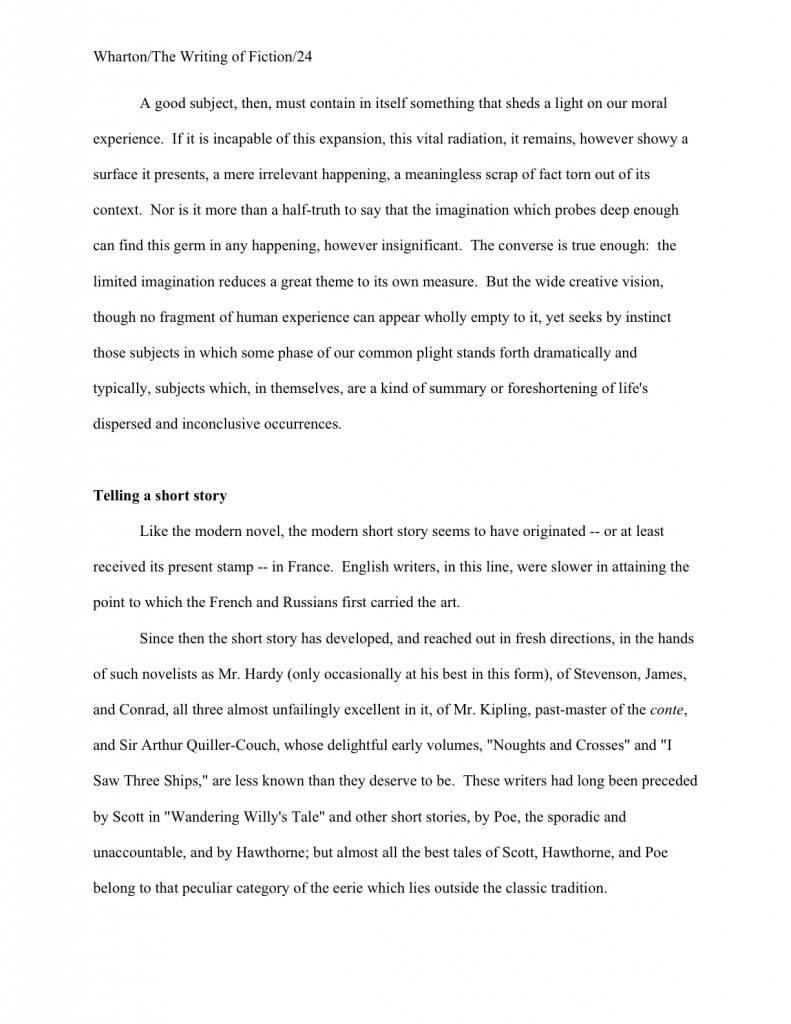
That caused some weary eyes to pop wide open, didn’t it? “But Anne!” the sharper-eyed exclaim, “that subheading is in BOLDFACE! Didn’t the rules of standard format specifically tell me never, under any circumstances, to boldface anything in my manuscript?”
Well caught, sharp-eyed ones: boldfacing the subheading does indeed violate that particular stricture of standard format. However, since nonfiction manuscripts and proposals have been routinely boldfacing subheadings (and only subheadings) for over a decade now — those crotchety old-fashioned editors are partially right about the creeping influence of article practices into the book world, you know — I thought that you should know about it.
It’s definitely not required, though; Millicent is unlikely to scowl at a nonfiction submission that doesn’t bold its subheadings. Like font choice, you make your decision, you take your chances.
In a fiction submission, though, I definitely wouldn’t advise it; those traditionalists I was talking about lurk in much, much higher concentrations on the fiction side of the industry, after all. Here’s the same page, formatted as fiction — and since we’re already talking about exceptions to the rules, let’s make this example a trifle more instructive by including a date and time in the subheading:

Unsure why I used numerals in the subheading, rather than writing out all of the numbers under a hundred, as standard format usually requires? Full dates, as well as specific times, are rendered in numeric form in manuscripts. Thus, 12:45 a.m. on November 3, 1842 is correct; twelve forty-five a.m. on November three, eighteen hundred and forty-two is not. (It would, however, be perfectly permissible to include quarter to one in the afternoon on November third.)
Everybody clear on that? Now would be a dandy time to raise your hand, if not. Or perhaps engage in some ice dancing; I like watching that.
I have quite a bit more to say on the subject of first pages of chapters, but I’ve just noticed the clock: I seem to have written straight through the curling match! If only I had reason to believe a similar match would be televised in the wee hours of tomorrow night…oh, wait; one is.
Who could have predicted that, eh? Keep up the good work!
Thanks Anne, I’ve been wondering how to do that page break for a long time now. It’s been driving me nuts!
Glad to see I’m not the only one who was busy watching the ice dancing into the wee hours last night. 🙂
I’m glad it was helpful, Jean! Actually, though, it wouldn’t have occurred to me to mention, had intrepid readers Lucy and Ken not asked about it. One of the side effects of working with standard format for decades on end is that it’s easy to stop thinking about the underlying logic, so I’m deeply indebted to readers’ questions for showing me where to clarify my explanations. Today’s bit about dates and times, for instance: I have Icy and Janet to thank for that one.
Hooray for community!
Thank you for clarifying ^_^
So, next questions (you must be a woman with infinite patience). A character is reading a diary entry. Would the format look as you’ve shown above, with a date as a sub-heading then straight into text? Should it be a block quote? Should it be in italics? Or is plaintext correct?
Thanks very much.
Icy.
I’m not sure I’ve ever done a post on that, Icy — but conveniently enough, there’s a post on letters in manuscripts coming up. Since I can’t post images of pages here in the comments (a fluke of the system), I’ll make sure to include a diary example in that post.
(The following is for Windows. I think it’s the same on a Mac, but I have no way to know for sure.)
There’s an easier way to insert a page break: hold down the CTRL key while pressing ENTER (or RETURN, if that’s what your keyboard happens to call it).
BUT! Microsoft Word can get cranky around page breaks, no matter how you insert them. The problem is that Word doesn’t consider a page break to mark the end of a paragraph.
If you just type up through the period of the last sentence of chapter 3, put in a page break, type the words “Chapter Four”, and center the chapter heading, Word will also center the last paragraph of chapter 3. If you go put that paragraph back to left-justified, then your “Chapter Four” heading ends up left-justified. It’s because Word thinks that they’re both in the same paragraph.
The fix seems simple. At the end of chapter three, after the last period of the last sentence, press ENTER to end the paragraph like you normally would and then press CTRL-ENTER to go to the new page.
That almost works. But if chapter three happened to end on the last line of the page, you now will have a blank page between chapters. Yuck. You could leave out the page break, but then if you change the length of chapter three, chapter four will no longer start at the top of the page.
A better way to handle this is to create a new style for chapter headings. Base it on your normal style, centered, and in the Paragraph “Line and Page Breaks” tab, check the “Page break before” box. Now you don’t need to put in any page breaks at all, just apply your new chapter heading style to “Chapter Four” and its brethren.
Oops, one more thing. On that new style that you make, set the “Style for following paragraph” to be the same as your normal style (usually shown in the “Style based on” just above it).
Otherwise, if you apply your new style to the chapter title *before* pressing ENTER to end the paragraph, when you do press ENTER Word will expect you to enter yet another chapter title… on a new page.
That’s very helpful, Doug! I suspect that this is one of those things that’s just a whole lot easier on a Mac — I couldn’t recreate the centering/left justification problem you mention on mine, and I’ve actually never seen the problem in a Mac-generated document. But then, no one even pretended that Word for Mac and Word for Windows were remotely similar until Version 5 or so. Speaking of which: I just tried the Control + Return trick on my Mac, and nothing happened.
I wonder, though, what would happen on Word for Windows if you made a hard paragraph break — hit the return key, in other words — at the end of the line that you want to be the last on the page, then left-justified the next line of the paragraph when it appeared on the next page. When you printed it out, that would appear to be a continuous paragraph carried over two pages, no?
Hello Anne,
It has been a long time since I’ve read and commented on your blog, but I am still plugging away at getting my novel published.
I spotted a notice of your first page contest and so I spent several hours today reading your series on standard format which always brings up new aspects to consider before submitting.
I realized that I have something on my first page that I could not find mentioned in this most recent round of posts. I think my question best fits in this comment trail.
I want to know how Millicents expect to see a line which denotes when the story takes place.
For example, mine is:
Summer Solstice in the year 802
I had been italicizing it and having it centered in a line double spaced above my opening line.
Now, I am wondering where I ever came up with the idea that it looked right.
Should it be in plain text? Should it be centered and under Chapter 1? Should it be indented and simply a line above the opening line? Or should there be a break between that line and the opening line?
All of a sudden I have analysis paralysis on this matter. I started monkeying around and trying about five different ways. Maybe only one would be considered right and the rest would make the Millicents of the world simply hit the reject button.
I am ever so grateful to discover that you extended the deadline by a week so that I might pose this question to you.
Linda
P.S. To demonstrate that I did try to find this subject covered in your archives I wanted to share with you an anecdote I have about my own political geekiness on the U.S. Supreme Court. In 2008, I spoke to a classroom of sixth grade students about the presidential election. I not only named the nine sitting Supreme Court Justices, I included the presidents who nominated them. The real kicker of that demonstration was to impress upon the students about the long term impacts of these justices by explaining that Justice John Paul Stevens had been appointed when I was their age and in sixth grade.
Nice to hear from you again, Linda! Glad to hear that you’re still pushing forward.
The short answer to your question is that you didn’t read far enough in this latest series on standard format: I did a post that deals very directly with this issue last March — here’s the link. You might have skimmed past it, since it’s a post mostly on letters and diary entries, but it does in fact talk about time and place entries. Take a gander at it, and if you still have questions, let me know.
There’s one issue that you raise that is not addressed there, though: italics would never be proper in such a heading, no matter where you placed it on the page. You should either treat it like a subtitle (i.e., place it on the line below the chapter heading, as I demonstrate in this very post) or as a subheading (as I demonstrate in the post above).
If you can think of a subheading for the archive list that would have made it easier for you to find this info, please let me know. (It would have to be under 40 characters.) Readers are often too impatient to skim through the entire HOW TO FORMAT A MANUSCRIPT series. I’m hesitant to keep adding categories for their benefit, though, because a fairly high percentage of the impatient apparently aren’t willing to scan all the way through the category lists.
Anne,
Thank you for yor reply to my question. I had read that post and it helped me with the few letters I am using in my manuscript. That post actually helped me wonder as to the proper way to handle a date on the opening page. It is the only time I use a date and that is to establish the year and season to ground the reader as to when the story takes place.
After your detailed exhortation against the practice of having the first paragraph in a chapter flush left, I wanted to verify this nuanced difference. I did start breaking out in a neurotic sweat about this tiny matter, but since it is before my first real line I didn’t want it to be Wrong, Wrong, Wrong.
Thank you again for clarifying this and for letting me know that italics is out of the question. I will make my adjustments accordingly.
Linda